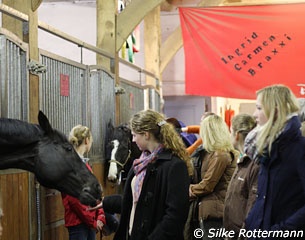
Ingrid Klimke might be one of the busiest riders on the international circuit and scheduling a visit with her at home is a challenging task. So when I planned a week at Warendorf I was not too optimistic, but became overjoyed when Ingrid's mum Ruth Klimke sent me a message that I can take part in an "open training" Ingrid and her team organise monthly to give visitors insight in her stable and training.
Getting to Know a Stable of Personalities
With the sun shyly blinking from behind ever-present grey clouds, I travelled to Hof Schulze-Brüning where Ingrid keeps and trains her bunch of eventing and dressage horses. The property is located near the inner-city of Munster but the GPS leads me in two minutes away from the hustle and bustle of a big town to a more quieter area with a canal at my right hand side.
Hidden behind trees and with no sign saying I reached my destination Hof Schulze-Brüning came in sight. Sure enough I discovered the stoney house to the right but had to cross a small bridge, from where I saw some sheds to the left and a stable building to my right. Lots of carswere parked here and I discovered there are more stables behind. I was happy to see Ruth slip in to the first stable on the right, so I know where to go to. I was 10 minutes late and Ingrid had already started her programme. I walked up the two steps and found myself amongst 20 people standing in the stable-corridor. Ingrid was in front of eventer Parmenides' stall and talked to him while her daughter Greta looked after her cheeky looking chestnut pony Nemo, who shares a box with her first pony, Shetland paint Barnaby.
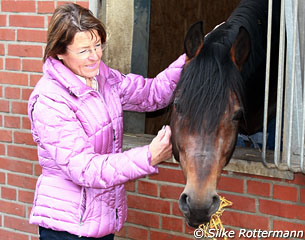 The whole stable complex belongs to Ingrid. There are modern, airy loose boxes built in a historic building which served as a shed long time ago. Ingrid moved from horse to horse, informing us on their history, habits and talents. From the first moment on I loved listening to her as she spoke frankly and enthusiastically about her equine partners as if talking about human beings.
The whole stable complex belongs to Ingrid. There are modern, airy loose boxes built in a historic building which served as a shed long time ago. Ingrid moved from horse to horse, informing us on their history, habits and talents. From the first moment on I loved listening to her as she spoke frankly and enthusiastically about her equine partners as if talking about human beings.
All her horses had their heads hanging out of the stalls and followed their rider's every step. Some could not bear watching Ingrid pay attention to a stable-mate and started kicking the walls of their stalls with their frontlegs. As soon as Ingrid came to them they calmed down, looking content and happy.
Her current Grand Prix horse Liostro appeared much smaller in the stable than under saddle. The well-bred Hanoverian looks like a nice ladies-horse. Next to him lives Dresden Mann, a most beautiful Westfalian who had been a licensed stallion until last year. "Alfi has been gelded a year ago because he was a very strong-minded stallion and it just didn't help him focusing on his work. He saw an enemy in every other stallion, which wasn't very relaxing at shows," Klimke explained. "In agreement with the owners we decided to geld him. Now he is easier to work with and it has really paid off," Ingrid reported cheerfully.
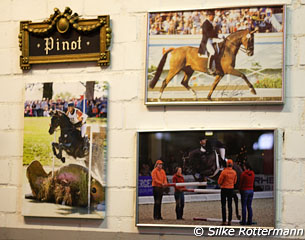 She turned to her Olympic eventing champion Abraxxas (aka Braxxi) whom she often calls 'pony.' He lives in the first box from the entrance and looked relaxed, almost sleepy. I had seen this Hanoverian by Heraldik xx looking more a thoroughbred than anything else at the CCI's in Aachen and Luhmühlen. I was really surprised how tiny and narrow he really is. He seems to grow inches under Ingrid!
She turned to her Olympic eventing champion Abraxxas (aka Braxxi) whom she often calls 'pony.' He lives in the first box from the entrance and looked relaxed, almost sleepy. I had seen this Hanoverian by Heraldik xx looking more a thoroughbred than anything else at the CCI's in Aachen and Luhmühlen. I was really surprised how tiny and narrow he really is. He seems to grow inches under Ingrid!
While everybody paid attention to the gold medal winner I discovered a most beautiful horse on the opposite side: a dark liver chestnut with shiny red mane and a wonderful topline. Ruth Klimke told me that her daughter had just got this 3-year-old stallion, owned by a Luxemburg couple. He was recently broken in and previously stood at the State Stud Warendorf.
Though it was raining cats and dogs, the mass followed Ingrid outside. I took my time looking at the framed pictures in the corridor: Ingrid and Braxxi on cross country, Damon Hill jumping a fence after he won the Burgpokal final, of course her father on Ahlerich at the 1984 Los Angeles Olympics, and clearing a grueling spread on his mare Winzerin at the 1960 Olympics.
A Reminiscence of Caprilli
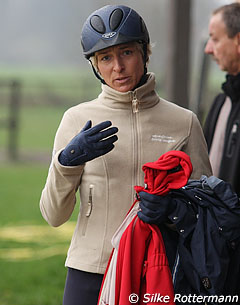 To the left was a big outdoor arena with a sandy surface where several fences, cavaletti, and a bank and chair were standing around. Ingrid's faithful long-time groom Carmen Thiemann who did her apprenticeship at Dr. Reiner Klimke years ago, lunged a dark bay horse. Ingrid asked her visitors to stand under the roof attached to the indoor arena to shelter from the rain.
To the left was a big outdoor arena with a sandy surface where several fences, cavaletti, and a bank and chair were standing around. Ingrid's faithful long-time groom Carmen Thiemann who did her apprenticeship at Dr. Reiner Klimke years ago, lunged a dark bay horse. Ingrid asked her visitors to stand under the roof attached to the indoor arena to shelter from the rain.
Ruth Klimke looked after Ingrid's two dogs, an enchanting whippet bitch and a self-confident looking Jack-Russell-terrier bitch, Sunny and Lilofee. Her own Cairne terrier bitch Fee was kept on the lead "as she sometimes escapes."
Ingrid mounted her first horse, the 7-year-old Hanoverian eventer gelding Llanero.
Neither horse nor rider minded the pouring rain. The dark bay loved to canter. Ingrid kept him in a quiet rhythm and tried to keep him calm when jumping, but the gelding was overly motivated and became quite strong in between two fences. Still he jumped them beautifully.
Ingrid never failed to explain every step in her training. Her daughter Greta helped out everywhere; no matter if it was carrying cavaletti, taking fleece-rugs off horses or ride all of Ingrid's more or less huge horses in walk after work. Greta acted like she had done this all her life long, which the 9-year old has indeed!
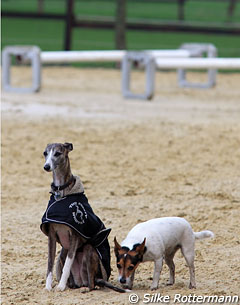 For a short moment the attention of the visitors switched from Ingrid and her daughter to her Mum who had let Fee loose. The small hair ball didn't hesitate long and went flat-out to the field nearby, Sunny and Lilofee in hot pursuit! Ruth Klimke called out for them, Greta gave her a helping hand and Sunny was the first to return ruefully. After some conviction the other two dogs returned as well. Ruth Klimke takes Fee at the lead again and the other two were looking as innocent as can be.
For a short moment the attention of the visitors switched from Ingrid and her daughter to her Mum who had let Fee loose. The small hair ball didn't hesitate long and went flat-out to the field nearby, Sunny and Lilofee in hot pursuit! Ruth Klimke called out for them, Greta gave her a helping hand and Sunny was the first to return ruefully. After some conviction the other two dogs returned as well. Ruth Klimke takes Fee at the lead again and the other two were looking as innocent as can be.
After the dogs' interlude the training continued with Escada JS, which had been lunged by Carmen beforehand. The 8-year-old Hanoverian mare (by Embassy) was bought by renowned sponsor Madeleine Winter-Schulze, who also owns several of Isabell Werth's and Ludger Beerbaum's top horses. Thanks to her Ingrid not only has this very promising eventing mare in her stable, but was also able to keep beloved Abraxxas after the Olympic Games in Hong Kong where a nerve-wrecking poker game began to sell the horse. Escada seems to be a very special horse, she is a high quality eventing prospect with a canter which is always even and in rhythm. Ingrid worked her on serpentines over cavaletti and the bay was happily paying attention to her at all times.
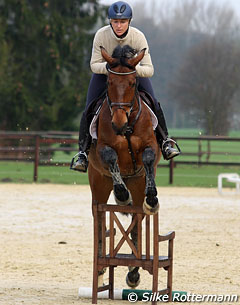 Both didn't bother the heavy raindrops splashing down. Ingrid used the walking breaks to explain what she was doing and Escada stood with completely given reins and looked interested at all the people. She never moved a step in any direction until her rider asked her to go on. Ingrid showed the group a neckring made of thin leather. "I use it as a help to control the speed. Escada reacts nicely to the pressure near the breast." Ingrid steered this sympathetic mare to a garden bank and then to a narrow wooden chair which Escada beautifully cleared without swaying the slightest before take-off. It was impressive proof of Ingrid having the horse between legs and hand, as well as of the joy this mare showed while jumping.
Both didn't bother the heavy raindrops splashing down. Ingrid used the walking breaks to explain what she was doing and Escada stood with completely given reins and looked interested at all the people. She never moved a step in any direction until her rider asked her to go on. Ingrid showed the group a neckring made of thin leather. "I use it as a help to control the speed. Escada reacts nicely to the pressure near the breast." Ingrid steered this sympathetic mare to a garden bank and then to a narrow wooden chair which Escada beautifully cleared without swaying the slightest before take-off. It was impressive proof of Ingrid having the horse between legs and hand, as well as of the joy this mare showed while jumping.
The inventor of the modern jumping position, Italian Federico Caprilli, was the first in equestrian history to demonstrate the obedience of his horse jumping a chair. Ingrid and Escada seemed to follow in his footsteps more than a century later!
As soon as the rain had stopped, a cold wind started to blow when Ingrid helped Greta in Escada's saddle and put a fleece-blanket on the soaked mare. Cool as a pro Greta walked her between the fences. Her mum had no time taking care of this any longer and asked the visitors to follow her to the property's beautiful small lounge attached to the nearby indoor arena. Ingrid's staffers served sandwiches, cakes, coffee and tea while their chief picked up the conversation. Ingrid has an amazing talent to talk to anybody as if it were an acquaintance, which prompted frank questions from the audience.
Dressage Magic
I was happy we were moving to the indoor after the 20 minute coffee break. While her bereiters warmed up some horses, Ingrid commented on the ride of her former apprentice Lara Heggelmann. Suddenly a slight uproar arose as Ingrid's long-time trainer Major Paul Stecken entered the indoor arena. I could not believe my eyes how quick and determined he was moving to Dresden Mann, the first dressage horse Ingrid was going to ride herself that day.
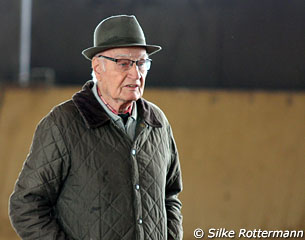 Stecken is an unbelievable 95 years, but one would never think this former chief of the Westfalian Riding School in Münster could be that age. In January the remarkable man drew the attention of a wider public in Germany with an interview by Evi Simeoni in the Frankfurter Allgemeine Zeitung (FAZ). Stecken, one of the last surviving witnesses of the 1936 Olympic equestrian Games in Berlin and of the legendary Cavalry School of Hanover, did not shy away fom finding clear words to describe Totilas' status and the wrong way of training dressage horses.
Stecken is an unbelievable 95 years, but one would never think this former chief of the Westfalian Riding School in Münster could be that age. In January the remarkable man drew the attention of a wider public in Germany with an interview by Evi Simeoni in the Frankfurter Allgemeine Zeitung (FAZ). Stecken, one of the last surviving witnesses of the 1936 Olympic equestrian Games in Berlin and of the legendary Cavalry School of Hanover, did not shy away fom finding clear words to describe Totilas' status and the wrong way of training dressage horses.
Ingrid welcomed the man who also trained her late father Dr. Reiner Klimke. Stecken immediately began working with her and Dresden Mann. The gelding still has the expression of a stallion with his almost perfect conformation and ideally muscled topline. Though difficult when he was still a stallion, the now-gelding showed good behaviour even though he flattened his ears extremely when he passed another horse in the arena. Still he didn't evade Ingrid's control.
"Today I am working Alfi in a double bridle. I don't like that too much as I prefer riding my horses in a snaffle, but once a week we have to use the double bridle to get the horses used to it when they need to start with it on shows. Alfi is planned to compete in the Nürnberger Burgpokal qualification this season and after the Burgpokal I would love moving on to young horses Grand Prix classes."
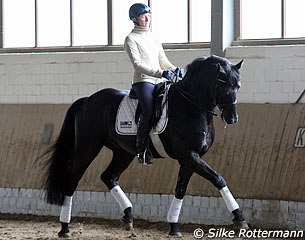 Even though Dresden Mann was already warmed-up, Ingrid stared riding him over her highly valued cavaletti which are set in a quarter of a circle. The black gelding was absolutely focused, moved over them in a ground-disdaining way arching his back and activating his hind legs powerfully. Even though he seemed to be a bit strong it was close to magic what was presented there: the kind of dressage one desperately looks for at umpteen shows.
Even though Dresden Mann was already warmed-up, Ingrid stared riding him over her highly valued cavaletti which are set in a quarter of a circle. The black gelding was absolutely focused, moved over them in a ground-disdaining way arching his back and activating his hind legs powerfully. Even though he seemed to be a bit strong it was close to magic what was presented there: the kind of dressage one desperately looks for at umpteen shows.
Dresden Mann was with an ideal contact and almost too light in the bridle, an impression later confirmed by Ingrid who remarked that to the visitors. The horse was in exemplarily self-carriage, never a second behind the vertical, the curb rein about 2 centimetres longer than the one of the bridoon. There was harmony between horse and rider and it created absolute delight. At the end of the demo Dresden Mann happily and without hesitation headed to Mr Stecken who of course had a treat ready to praise him.
The Revival of the Obedience Jump
Ingrid then mounted her Grand Prix horse Liostro while Stecken asked the audience if they had any question. Nobody seemed brave enough. Liostro, a short compact horse and for sure not bigger than 16 hh, wore a dressage saddle which, like Ingrid's riding, is rarely to be seen on the international stage. It has a well-formed seat, but almost no knee-rolls, let alone that monster-like padded ones which press the rider's leg in an immobile position. The flat saddle flaps allow a close contact with the horse, but on the other hand require a very good seat which needs no support from the saddle. Like her father did all his life also Ingrid continued using simple cotton-string saddle-girths which have practically disappeared from today's tack-shops and are rarely in use anymore.
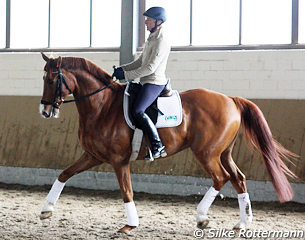 Ingrid started working Liostro who, like his famous namesake in the 1970s, is a Hanoverian bred chestnut by the Laptop son Le Primeur out of a Wenzel I dam. He was previously ridden by Luxemburg Fernand Wetz and more recently by Birgit Finken. Ingrid took him over less than a year ago and clicked quickly as their first Grand Prix wins in the mid 70s came quickly. Stecken discussed the advantages and disadvantages of the horse-type Liostro presents, the square horse.
Ingrid started working Liostro who, like his famous namesake in the 1970s, is a Hanoverian bred chestnut by the Laptop son Le Primeur out of a Wenzel I dam. He was previously ridden by Luxemburg Fernand Wetz and more recently by Birgit Finken. Ingrid took him over less than a year ago and clicked quickly as their first Grand Prix wins in the mid 70s came quickly. Stecken discussed the advantages and disadvantages of the horse-type Liostro presents, the square horse.
"You can see that this horse is rather short and compact which has the undeniable advantage that you can close the horse much easier than with one having a long back," Stecker said. "It is easier to make the hind-legs move under the centre of gravity. But you have to be very careful that such horses don't become stiff in the costal arch. Tension can much more easily be detected in such horses. So we have to take care to keep the costal arch smoothly which we can do for example by riding serpentines or other curved lines in the daily work. Then one can develop true impulsion instead of tense movements."
Liostro was wearing a snaffle with a correctly fitted dropped noseband. He chewed quietly all the time and like Dresden Mann was in beautiful contact with the bit. The copybook outline he presented most of the time, neck as the highest point and nose in front of the vertical, was only possible because he was honestly carrying himself. Ingrid later told me that she had worked on the horse's self-carriage, in particular in the piaffe "in which he used to drop down with the neck, but now knows what I ask of him."
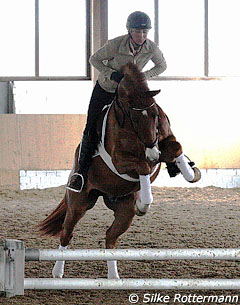 Ingrid is an extremely successful eventing rider and has also been victorious up to S-level jumping, so it seems only logical that she includes cavaletti work daily, also with her dressage horses who profit from it the same way as her eventers. With Liostro she demonstrated the obeidence jump, which was a revival of what had been decisive on victory, placings or complete failure at international Grand Prix competitions until the 1960s.
Ingrid is an extremely successful eventing rider and has also been victorious up to S-level jumping, so it seems only logical that she includes cavaletti work daily, also with her dressage horses who profit from it the same way as her eventers. With Liostro she demonstrated the obeidence jump, which was a revival of what had been decisive on victory, placings or complete failure at international Grand Prix competitions until the 1960s.
I was sure Liostro hasn't seen a fence very often before and the first time Ingrid steered him to the low white pole the horse's eyes almost popped out. He wanted to make it right for his rider, but at the same time wasn't brave enough to take off. Ingrid smilesd and allowed him to look and sniff at the white pole. Then she tried again and this time 'Lio' set off and cleared the small fence by inches, being a bit askew in the air, but very careful.
Everybody was delighted and Ruth Klimke took over Liostro to walk him around because Greta was already on the next horse, Abraxxas.
An Olympic Champion Goes Indian
After the retirement of Ingrid's fabulous English Thoroughbred Sleep Late, the 2006 WEG team gold medallist, double OLympian and with whom she came second in the world's toughest three-day-event at Badminton, Abraxxas came into the spotlight on the eventing circuit. The now 15-year-old almost-thoroughbred (by Heraldik xx / Kronenkranich xx) is a very special horse and has formed an incredible strong bond not only with Ingrid, but also with his groom Carmen.
 A horse that can "read and write“, has cleared the most difficult cross-country courses with panache and great enthusiasm, his team thought about how to entertain him over the winter in preparation of another Olympic year. "This winter we worked him at Prix St. Georges level,“ said Ingrid while riding beautiful flying changes under Stecken's watchful eye. Abraxxas is a completely different type to Liostro or Dresden Mann. He is comparatively diminiutive, almost petite, a real blood-horse with according paces. You can see that he is extremely well-ridden and correctly trained because despite him lacking the big movements of his dressage colleagues he is still able to extend and moves with the same wonderful self-carriage and active hind-legs.
A horse that can "read and write“, has cleared the most difficult cross-country courses with panache and great enthusiasm, his team thought about how to entertain him over the winter in preparation of another Olympic year. "This winter we worked him at Prix St. Georges level,“ said Ingrid while riding beautiful flying changes under Stecken's watchful eye. Abraxxas is a completely different type to Liostro or Dresden Mann. He is comparatively diminiutive, almost petite, a real blood-horse with according paces. You can see that he is extremely well-ridden and correctly trained because despite him lacking the big movements of his dressage colleagues he is still able to extend and moves with the same wonderful self-carriage and active hind-legs.
Stecken remarked on something very important and almost forgotten today, as the thoroughbred horse has more or less disappeared from the FEI rectangles: "Here you see the typical paces of a thoroughbred. They are not less worth than of the horses we saw before, they are just different! I repeat: Different, but not worse." Living in times in which big moving horses are bred, the principles of a true correct extension remain the same, no matter executed by a thoroughbred or a refined warmblood. The lengthening of the steps, the active hind-legs moving far under, the even rhythm and the lengthening of the topline are the requirements of a true and valuable extension, not just big movements which might make it easier to create a good extension, but are useless without the rest, even though they are spectacular.
 Ingrid jumped off and Braxxi stood between her and Stecken without moving a step. Carmen removed the saddle and the bridle and put a neck rope around the gelding.
Ingrid jumped off and Braxxi stood between her and Stecken without moving a step. Carmen removed the saddle and the bridle and put a neck rope around the gelding.
Ingrid gave her a leg and Carmen began riding him bare-back like an Indian. She trotted and cantered and steered the Hanoverian only with her weight. Abraxxas' ears were listening and he was in unison with Carmen, who quietly smiled. Ingrid revealed that she hacks Abraxxas like that.
The last horse of the day was the wonderful liver chestnut stallion I had taken notice of in the stall earlier. Lara Heggelmann sat on him while Ingrid introduced Stecken to the newest member of her barn. An ideal dressage horse was in front of us: correct conformation, three superb gaits, incredible charm and expression, the perfect topline and a striking colour.
Lara rode him sympathetically on long straight lines as the licensed Westfalian called Shatterhand (by Swarovski x Pik Labionics) just got broken in and didn't have much strength. Stecken expressed that he very much likes this horse: "With a horse having such a perfect topline one needs to be very very soft with the hands, otherwise such a horse easily comes behind the vertical." When Stecken found out about the 3-year old's age he frankly remarked, "But this is young, too young. One has to wait longer." Ingrid agreed, replying that the horse will have a very slow and easy training the next months, mainly spending it in the field to grow and settle.
Some Anecdotes for Lunch
The open training was over, but Ingrid had to pose for pictures with fans and even Stecken was asked to smile into the lense before he left the indoor. I listened to him with open-mouth. There just cannot be somebody his age so agile in every aspect. He even listened with great interest to Ruth Klimke explaining him how Facebook works and where can you see video clips of Ingrid training her horses. Paul replied, „It is in the computer, yes? I don't have one, so you have to show me that!."
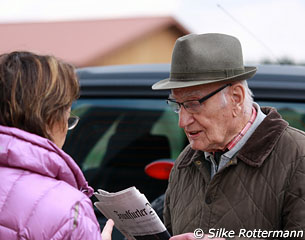 Ingrid managed to come outside, but other fans were waiting, now asking questions they didn't during the coffee break. Finally the last visitors were gone and I followed Ruth to join Ingrid for lunch. I was escorted to Ingrid's beautiful modern styled home only some streets away from her mum's.
Ingrid managed to come outside, but other fans were waiting, now asking questions they didn't during the coffee break. Finally the last visitors were gone and I followed Ruth to join Ingrid for lunch. I was escorted to Ingrid's beautiful modern styled home only some streets away from her mum's.
There was a big painting of Abraxxas in the entrance hall as well as a frame with several photographs of Sleep-Late xx.
We sat down at a round table next to the kitchen and had lunch. Ingrid was easy and fun talking to and sounded very genuine. "From my childhood days on I rode both eventing and dressage. My father introduced me to the cavaletti-work and working horses on the race-track. First I had Pinot who was a wonderful horse. Then one day my father came home with a three-year-old Westfalian he had bought from a client: Patriot. I tell you I was not enthusiastic at all when I saw that heavy, ugly horse and heard he should be mine! My father said: 'Here you are, you can now start training him from the beginning'."
Ingrid got invaluable assisstence from her father and trained and competed the chestnut up to Grand Prix dressage. „In my school holidays I had been to jumping rider Fritz Lutter and we found out that Pats jumped outstandingly. He also placed in S-classes in jumping later on. Only eventing...“ Ingrid laughed thinking back. "I tried that at A-level, but my heavy short-legged warmblood just couldn't canter and we quickly abandoned the idea of eventing him."
Patriot led a long happy life at Ingrid's, only being put down about two years ago.
Greta who is already a real little lady raised her hand and told me that she rode Pats with a vaulting girth on. "She even did flying changes on him," grandma Ruth added proudly. "Just imagine, that big heavy horse and the little girl."
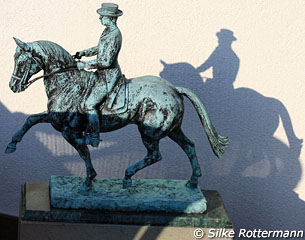 Greta continued talking on her recent horse, the chestnut riding pony Nemo. "I got him for my Holy Communion last year. He is a super pony, we jump cross country and I can always hold him. Only dressage, he doesn't like it too much." I smiled and thought that this will soon change in these surroundings! Ingrid told me that Greta had started Nemo in an E- class cross country and placed with the mark of 7,7. It was great to hear that the Klimke tradition will continue when Ingrid retires one day. The way Greta had handled all the horses in the morning showed me that she might be a natural like her mum.
Greta continued talking on her recent horse, the chestnut riding pony Nemo. "I got him for my Holy Communion last year. He is a super pony, we jump cross country and I can always hold him. Only dressage, he doesn't like it too much." I smiled and thought that this will soon change in these surroundings! Ingrid told me that Greta had started Nemo in an E- class cross country and placed with the mark of 7,7. It was great to hear that the Klimke tradition will continue when Ingrid retires one day. The way Greta had handled all the horses in the morning showed me that she might be a natural like her mum.
Ingrid said that after Patriot her first real classy dressage horse was the black Akhal Teke stallion Chan. This compact black gelding was her brother Michael's horse who won a bronze medal at the German Championships with him. She took over the grandson of 1960 Olympic Champion Absent "when he was already an older horse. He was still fit and a very safe Grand Prix horse. With him I really learnt to ride programmes and we shared some nice successes like winning the Special at Frankfurt or at Münster."
I asked for Nector van het Carelshof, a horse I clearly remembered because he made such an outstanding partnership with Klimke. Ingrid beamed hearing Nector's name: "He was so difficult at the beginning. He panicked with a saddle, so my husband rode him bare-back at the beginning. No pressure, just fun, so he got faith in us. Then we started to form a real partnership, first successes came and I was confident, but he had to be sold and we just couldn't raise enough money to buy him. He went to Fiona Bigwood where he now spends a great retirement in the field."
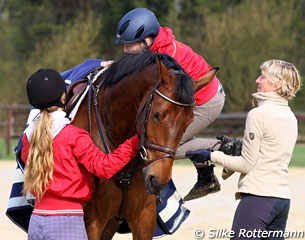 Ingrid's story is also one of horses being taken away or sold before they really blossomed with her. The Trakehner stallion Windfall came to my mind. He was her 2000 Olympic reserve horse and went to the USA, where he continued a very successful career. Then the big framed Trakehner Seacookie sold to William Fox-Pitt. Ingrid sighed deeply: „It was such a hard decision to sell him. My horses are part of my family, I am really attached to them. I couldn't sleep the whole night after I agreed selling Cookie and the next morning I decided to pull back, but it wasn't possible anymore. So he went to England."
Ingrid's story is also one of horses being taken away or sold before they really blossomed with her. The Trakehner stallion Windfall came to my mind. He was her 2000 Olympic reserve horse and went to the USA, where he continued a very successful career. Then the big framed Trakehner Seacookie sold to William Fox-Pitt. Ingrid sighed deeply: „It was such a hard decision to sell him. My horses are part of my family, I am really attached to them. I couldn't sleep the whole night after I agreed selling Cookie and the next morning I decided to pull back, but it wasn't possible anymore. So he went to England."
Damon Hill, which Ingrid trained up to Grand Prix-level, is another horse which could have taken her on a German dressage team. Now „Dami“ excels with Helen Langenhanenberg. "All these stories have taught me a lesson: I try either to own parts of the horses or do contracts. Not only do I not want to invest time in horses which are taken away later, but I just don't want to part with them as my heart is attached to all my horses."
During my walk on Klimke's premises I witnessed a rider who makes dressage become an art. I also met real horse people deeply caring for their equine partners. Ingrid has incredibly big footsteps to fill, but she did it with success and continues doing so brilliantly, making her a tremendous ambassador for the sport in its best sense.
Text and photos by Silke Rottermann for Eurodressage.com
Related Links
Horse-friendly Dressage Training with Klimke and Thomsen: Desensitise and Motivate
Ingrid Klimke and Damon Hill NRW No Longer a Combination
Ingrid Klimke Receives Riding Master Title
Liostro in Training with Ingrid Klimke
St. Moritz Junior in Training with Ingrid Klimke
Ingrid Klimke and Nector van het Carlshof, Revellations of the 2001-2002 Indoor Circuit
Greatest Oldies: Dr. Reiner Klimke's Ahlerich